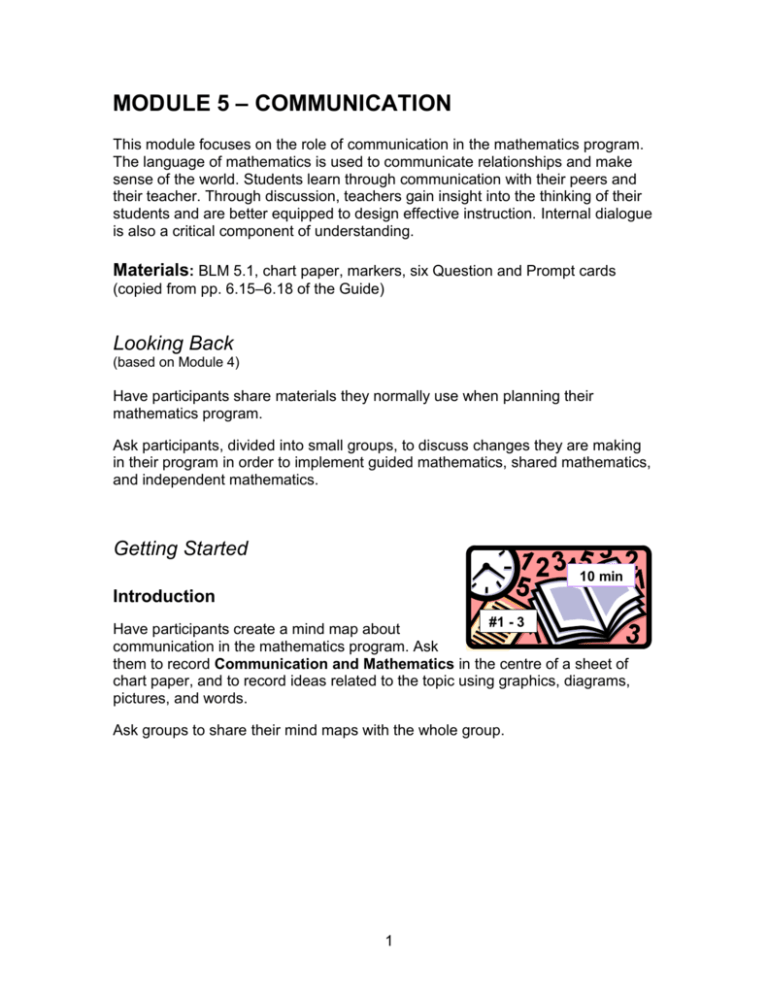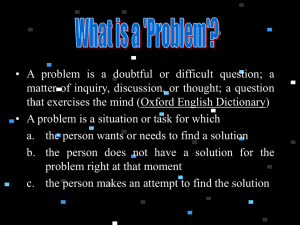
MODULE 5 – COMMUNICATION
This module focuses on the role of communication in the mathematics program.
The language of mathematics is used to communicate relationships and make
sense of the world. Students learn through communication with their peers and
their teacher. Through discussion, teachers gain insight into the thinking of their
students and are better equipped to design effective instruction. Internal dialogue
is also a critical component of understanding.
Materials: BLM 5.1, chart paper, markers, six Question and Prompt cards
(copied from pp. 6.15–6.18 of the Guide)
Looking Back
(based on Module 4)
Have participants share materials they normally use when planning their
mathematics program.
Ask participants, divided into small groups, to discuss changes they are making
in their program in order to implement guided mathematics, shared mathematics,
and independent mathematics.
Getting Started
10 min
Introduction
#1 - 3
Have participants create a mind map about
communication in the mathematics program. Ask
them to record Communication and Mathematics in the centre of a sheet of
chart paper, and to record ideas related to the topic using graphics, diagrams,
pictures, and words.
Ask groups to share their mind maps with the whole group.
1
Module 5 – Communication
KEY MESSAGES
At the heart of mathematics is the process of
setting up relationships and trying to prove
these relationships mathematically in order
to communicate them to others.
5 min
#4 - 8
The secret to successful teaching is being able to determine what
students are thinking, and then use that information as the basis for
instruction.
Through skilfully led discussion, teachers will gain insight into student
understanding and students will build understanding and consolidate
learning.
Students’ writing about their mathematical learning will also reveal and
consolidate understanding but must be prefaced by many oral
opportunities.
Whether students are talking or writing about their mathematical learning,
the most valuable question that a teacher can ask of them is, “How did
you know?”
2
Module 5 – Communication
Working on It
20 min
Promoting Opportunities for
Communication
#9 - 12
Fostering students’ communication skills is an
important part of the teacher’s role in the mathematics classroom. Teachers need
to be aware of the many kinds of opportunities that exist in the classroom for
helping students communicate.
Ask participants to read the list of bulleted statements on p. 6.4 of the Guide.
Arrange participants in groups of four to six. Have the groups create a graphic
organizer on chart paper and organize into categories ideas from the list on
p. 6.4.
Ask participants to record an additional example of an opportunity for
communication in each category.
Ask groups to share their graphic organizers with the large group. Discuss
similarities and differences.
3
Module 5 – Communication
Oral Communication
Teachers can promote students’ communication
skills by providing models of good communication,
such as:
20 min
#13 - 22
Helping students develop skills in problem
solving by demonstrating the thinking process for solving a problem and
modeling this process in oral dialogue;
Having student volunteers explicitly demonstrate what good communication
would, and would not, sound like;
Using prompts and questions that help students expand on their oral
responses;
Modeling prompts and questions that can be used by students as they work
together;
Encouraging students to use 'think time' before they communicate;
Encouraging concrete representation as a basis for communicating
mathematical understanding.
Use a jigsaw strategy (see Module 1, p. 4) to help participants explore strategies
for fostering oral communication. Arrange participants in home groups of six. Ask
participants to number themselves from 1 to 6 to identify their expert group
number. Assign a different strategy from pp. 6.6–6.7 to each expert group.
Ask participants to record information on copies of BLM 5.1 when they work in
the expert groups.
Have participants return to their home groups to share their findings. Participants
can complete other sections of BLM 5.1 as they listen to information shared in
their home groups.
4
Module 5 – Communication
Questions and Prompts for Promoting
Communication
The questions and prompts teachers use will vary
to reflect the purpose of the communication they
wish to elicit from students. At different times,
teachers ask students to:
20 min
#23 - 27
Retell;
Predict, invent, or problem solve;
Make connections;
Share their representations of mathematical situations;
Reflect on their work;
Share their feelings, attitudes, or beliefs about mathematics.
Have participants work in groups of four to solve the problem below.
Ask two participants in each group of four to play the role of ‘student’ and two
participants to play the role of ‘teacher’. Ask the ‘students’ to solve the problem.
Next, have the ‘teachers’ use the Question and Prompt Cards (copied from
pp. 6.15–6.18) to help them support their ‘students’ as they solve the problem.
TWO MACHINES, ONE JOB
Ron’s Recycle Shop was started when Ron bought a used paper-shredding
machine. Business was good, so Ron bought a new shredding machine as well.
The old machine could shred a truckload of paper in 4 hours. The new machine
could shred the same truckload in only 2 hours. How long would it take to shred a
truckload of paper if Ron ran both shredders at the same time? (See possible
strategy on p. 7.)
– Van de Walle, Elementary and Middle School Mathematics: Teaching
Developmentally, Fourth Edition, 2001, Pearson Longman, p. 18
In a large group, ask participants to describe their experiences as students and
as teachers during the problem-solving situation.
5
Module 5 – Communication
Promoting Written Communication
Talk, then write
Model the writing
process
Use strategies that
promote written
communication
Provide authentic
writing tasks
Ask participants to number themselves from 1 to 5.
Organize participants in their number groups.
Explain that each group is responsible for studying
three strategies for promoting written
communication. Ask the groups to record their
ideas on chart paper.
20 min
#28 - 30
Group 1 –
Mind Mapping, Model Writing, Shared Student Writing (pp. 6.9–6.10)
Group 2 –
Think-Talk-Write, Thinking Windows, Place Mat (pp. 6.10–6.11)
Group 3 –
Procedural Writing, Graphic Organizers, Word Wall (pp. 6.11–6.12)
Group 4 –
Strategy Wall, Journals/Logs, Picture Books (pp. 6.12–6.13)
Group 5 –
Poster Projects, Problem Posing, Creative Writing (pp. 6.13–6.14)
Ask groups to present their work to the whole group.
6
Module 5 – Communication
Reflecting and Connecting
10 min
In Your Classroom
Encourage participants to think about
#31
communication as they plan their math lessons in
the next few days. Ask them to focus specifically on
the prompts and questions they use to help students communicate. Ask them to
be prepared to share their thoughts about communication in the mathematics
program at the next session.
For Next Time
Ask participants to read Chapter 7 – Classroom Resources and Management.
Possible Strategy for “Two Machines, One Job” (p. 5)
Since the old machine shreds a truckload of paper in 4 hours, it would shred
¼ truckload in 60 minutes. Since the new machine shreds a truckload of paper
in 2 hours, it would shred ½ truckload in 60 minutes. With both machines running,
they would shred ¾ truckload in 60 minutes.
If the two machines, running together, shred ¾ truckload in 60 minutes, they
shred ¼ truckload in 20 minutes. Therefore, it would take 80 minutes to shred
a truckload.
7








